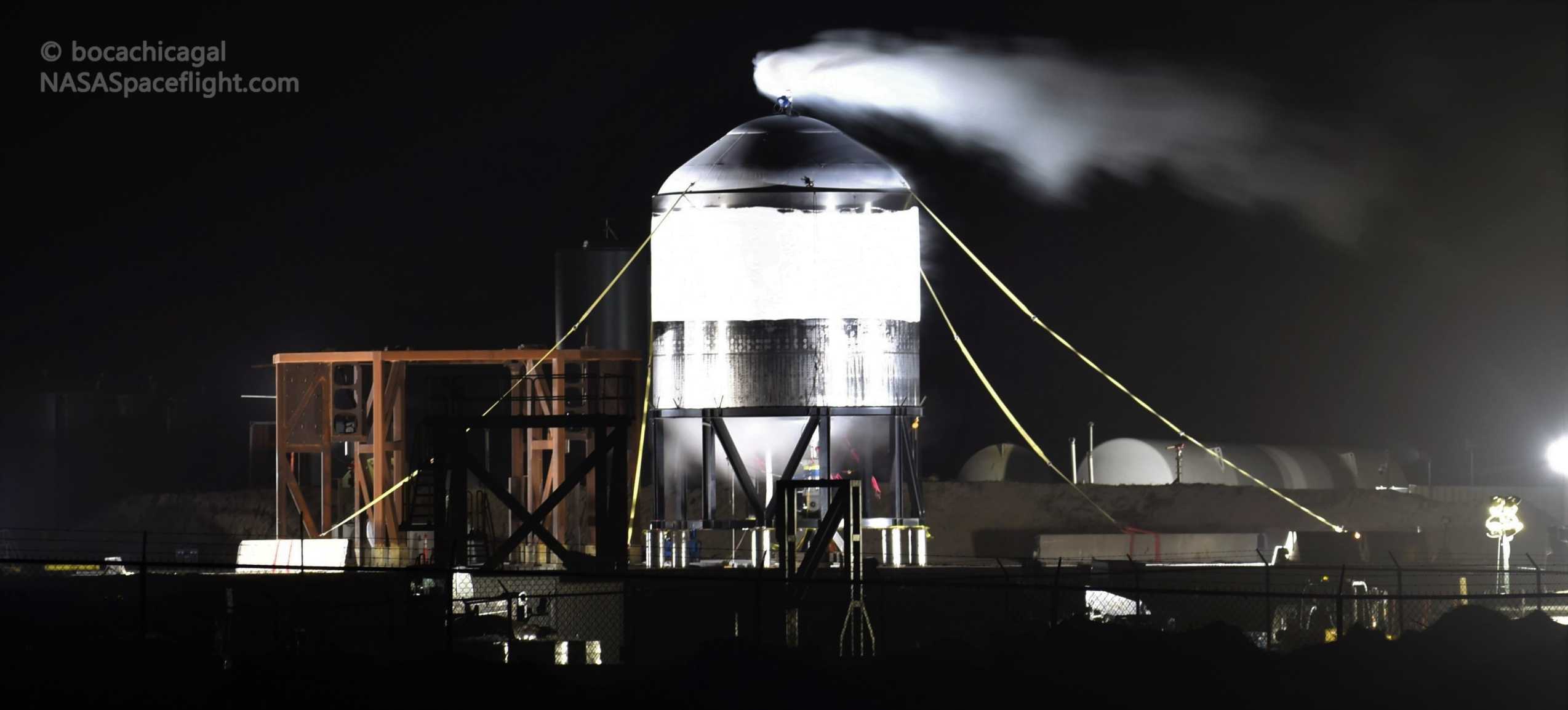

News
SpaceX's latest Starship test was uneventful and that's great news for its flight debut
According to Elon Musk, SpaceX has successfully completed its latest Starship prototype test in a uniquely uneventful fashion, great news for the next-generation rocket’s next steps and first flight tests.
The SpaceX CEO revealed the news some 12 hours after the company wrapped up the Starship tank test at its Boca Chica, Texas facilities. Another excellent example of SpaceX’s preferred process of agile development, the test followed just nine days after the Starship SN01 prototype’s first cryogenic test unexpectedly unearthed a design flaw. SpaceX analyzed the results of Starship SN01’s unintentional launch debut and drew up plans to rapidly repurpose a Starship tank initially destined for the SN02 prototype.
By using existing hardware to test an upgraded iteration of the part that destroyed Starship SN01, SpaceX has now effectively retired the risk posed by that prior failure less than two weeks after it occurred. Elon Musk specifically noted that the former SN02 engine section “passed cryo pressure & engine thrust loads,” confirming that there was more to the exceptionally uneventful evening of March 8th than met the eye. While putting on much less of a show for local observers, this particular boring test is a great sign for the next few steps of SpaceX’s Starship development program.
SN2 (with thrust puck) passed cryo pressure & engine thrust load tests late last night— Elon Musk (@elonmusk) March 9, 2020
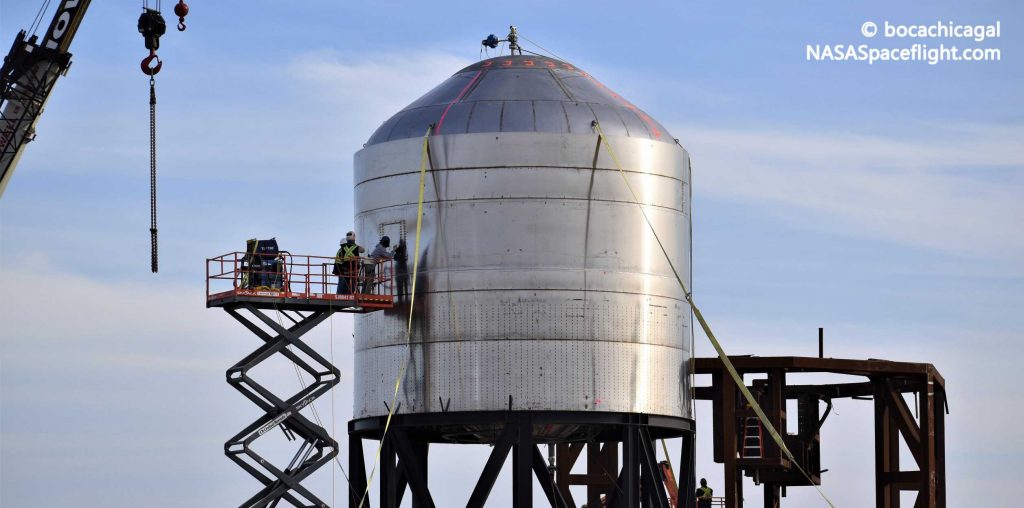
Simply put, despite successfully demonstrating that Starship’s improved “thrust puck” and engine section can survive flight-level tank pressures and the thrust of a Raptor engine, one would be hard-pressed to determine as much by inspecting the prototype that managed the feat. Such a visually uneventful test is a first for SpaceX’s post-Starhopper Starship testing, where “before” and “after” photos typically start with a shiny tank and finish with a well-distributed field of steel shrapnel.
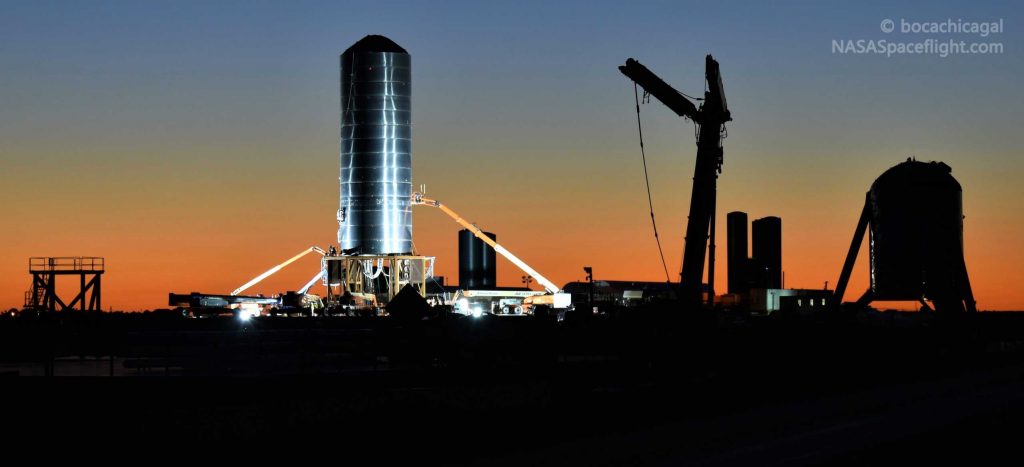
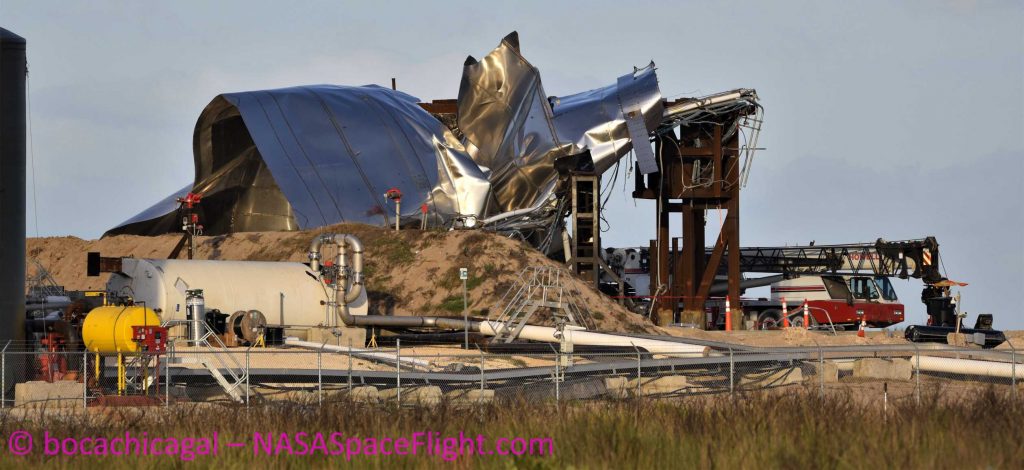
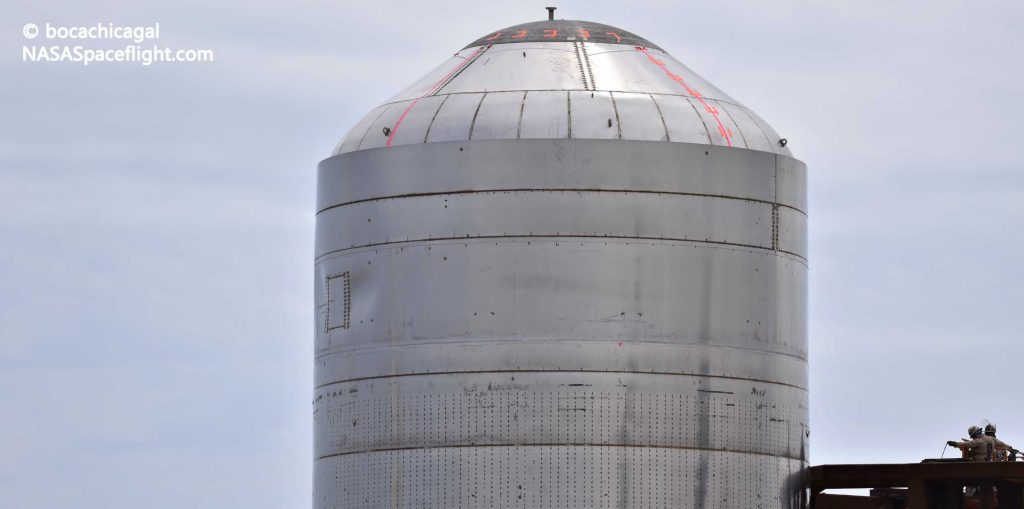
Musk’s description of the test suggests that SpaceX’s intention with the SN02 test tank – built in just two weeks – was to stress it up to (and likely beyond) the pressures and mechanical stresses Starship engine sections will need to survive in flight. In simpler terms, they likely tried to burst the tank by pressurizing it with liquid nitrogen, a supercool cryogenic fluid. It’s unclear exactly how far SpaceX pushed the tank, but it’s safe to say that it went at least as high as past test tanks, meaning 7-8.5 bar or 100-125 psi. At a bare minimum, a test that failed to reach Starship’s minimum flight pressure of 6 bar (90 psi) would be of dubious value for the actual orbital ship.
A step further, SpaceX installed a hydraulic jack underneath the test tank in a bid to simulate the stresses it would experience with a single Raptor engine. Capable of producing approximately 150-200 tons (1500-2000 kN) of thrust, even Raptor is relatively minor compared to the Starship tank’s likely ~500 metric ton (1.1 million lb) mass. Still, the fact that the SN02 test tank survived the combination of a highly pressurized tank and the simulated thrust of a Raptor engine suggests that SpaceX is now ready for a more successful repeat of Starship SN01 testing.
Confirming those suspicions, Musk subsequently revealed that the Starship prototype integrated immediately after the SN02 test tank will likely attempt the first Raptor static fire tests and may even perform short flights further down the road. As always, SpaceX’s testing programs are fluid and likely to change as new results continuously shape the path forward, meaning that Starship SN03 could easily be destroyed during testing. Starship SN04, said by Musk to be the hopeful candidate for “longer [test] flights,” would thus be repurposed to continue SN03’s test campaign — and so on with SN05, SN06, and beyond.
Regardless, as the CEO notes, perhaps the most important aspect of all these rapid-fire tests is that SpaceX is quickly building up an impressive Starship production line. Before, during, and after SN02’s test campaign, SpaceX’s South Texas team has been simultaneously fabricating and stacking new steel rings, bulkheads, and noses for the next few Starship prototypes. As a result, Starship SN03’s tank section could be just a week or two away from complete integration, after which SpaceX will likely transport it to the launch pad to prepare for Raptor static fire testing.
Check out Teslarati’s Marketplace! We offer Tesla accessories, including for the Tesla Cybertruck and Tesla Model 3.
Elon Musk
Elon Musk confirms Grok 4 launch on July 9 with livestream event
The rollout will be accompanied by a livestream at 8 p.m. Pacific Time.

Elon Musk has officially confirmed that Grok 4, the latest version of xAI’s large language model, will launch on July 9. The rollout will be accompanied by a livestream at 8 p.m. Pacific Time, hosted on xAI’s official account on X.
xAI goes straight to Grok 4
Back in May, leaks indicated that xAI was getting ready to ship Grok 3.5. Considering Musk’s recent comments, however, it appears that the artificial intelligence startup would be focusing on the large language model’s fourth iteration instead. As noted in a Financial Express report, users on X have sighted references to Grok 4 in the lead up to the update’s launch, such as “grok-4-prod-mimic” and “Grok 4 Code.”
Musk’s Grok 4 announcement comes as AI competition intensifies between major players including OpenAI, Google, and xAI. With Musk’s Colossus supercomputer fully operational in Memphis, xAI appears to be accelerating its AI product roadmap.
Musk pushes Grok toward political neutrality
Grok 4’s launch also follows a recent controversy involving political bias, as noted in a CNN report. Last week, Grok responded to a user on X stating that political violence in the U.S. since 2016 had come more from the political right than the left. The chatbot noted in a later reply that its answer was based on information from sources like Reuters, the Journal of Democracy, and University of Maryland studies.
Musk stated that Grok’s response was a “major fail.” “Major fail, as this is objectively false. Grok is parroting legacy media. Working on it,” he wrote in a post on X. By the end of June, Musk noted that he was “grinding all night with the xAI team” and that they were making “good progress.” He also stated that the model “Will be called Grok 4. Release just after July 4th. Needs one more big run for a specialized coding model.”
News
Tesla opens massive solar Supercharger station in California
The Supercharger opened to customers ahead of Fourth of July weekend, while Tesla continues phase two of construction on the site.

Tesla has officially launched the first several Supercharging posts at a massive station in California, notably including solar canopies and grid-scale batteries to offer completely renewable charging.
Last week, Tesla announced on X that it opened the first 84 Supercharger stalls of a planned 168-stall station in Lost Hills, California. Additionally, the massive Supercharger project features 11MW of solar canopies and 10 Megapack batteries for off-grid charging powered entirely by solar energy.
Tesla completed the first phase of the project just days ahead of the busy Fourth of July holiday weekend, adding that initial construction took just eight months. In addition to the remaining charging stalls, Tesla says it’s building a set of lounge areas, renderings of which can be seen below alongside current photos of the site.
Notably, the site also includes V4 charging posts for the company’s latest available charging speeds, and it’s located near the busy junction between I-5 and Highway 46 in Kern County.
“Thank you [Kern County] and [PG&E] for collaboration and approvals,” Tesla wrote in a follow-up post.

Credit: Tesla Charging | X

Credit: Tesla Charging | X

Credit: Tesla Charging | X

Credit: Tesla Charging | X
Tesla Supercharger Maps for North America, Europe, and Asia pic.twitter.com/0U5r0XRPyo
— TESLARATI (@Teslarati) July 2, 2025
READ MORE ON TESLA SUPERCHARGERS: Tesla launches ultra-fast V4 Superchargers in China for the first time
Testing at the LA Diner, plus Musk update on potential Tesla solar Gigafactory
The huge Tesla Supercharger station completed phase one of construction fairly quickly, especially given how long Tesla has been working on its unique Los Angeles diner, drive-in, and Supercharger location. Still, the company was seen performing some testing at the nearly-completed charging station earlier this month, and will reportedly be holding a job fair.
Elon Musk also responded on Monday morning to a post on X, suggesting that Tesla is “thinking about” building a U.S.-based solar Gigafactory in order to help support increased power needs with AI growth, and to bolster domestic solar production.
Tesla is building a new UFO-inspired Supercharger in the heart of Alien country
News
Tesla driver walks away from major accident with minor injuries
The driver sustained only minor injuries, and the exact cause of the crash remains under investigation.

The driver of a Tesla Model Y survived and walked away from a harrowing accident on Monday in California, only sustaining minor injuries despite the vehicle being impaled by a guardrail.
On Monday morning around 4:34 a.m., the Los Banos division of the California Highway Patrol (CHP) responded to the accident on I-5 near Panoche Road, involving a 23-year-old in a Tesla Model Y. According to a post on social media, the driver veered off the road for unknown reasons in the northbound lane, before crashing directly into the guardrail and impaling the vehicle.
You can read the full message and photos from Los Banos CHP below, as were shared in a Facebook post on Monday afternoon.
This morning a Tesla model y was traveling in the #1 northbound lane of I-5 north of Panoche Rd. For unknown reasons driver allowed V-1 to veer off the roadway, travel through a dirt center divide, and crashed into the fixed metal guardrail. Lucky for the driver he only sustained minor injuries and was able to walk away. Driving a vehicle requires 100% attention to the road. Avoid distractions and focus on driving.

Credit: CHP Los Banos (via Facebook)

Credit: CHP Los Banos (via Facebook)

Credit: CHP Los Banos (via Facebook)
In a statement to SFGate, CHP officer Myles Anderson said that the driver only sustained minor injuries, while no arrests are made and drugs and alcohol are not suspected to have been involved. The report also notes that Tesla’s “cruise control and lane assistance features” were activated, according to Anderson. However, it’s not entirely clear if this is referring to Supervised Full Self-Driving (FSD), or to the cruise control and lane assist features baked into Autopilot.
At the time of writing, CHP has not yet responded to Teslarati’s request for clarification and additional details on the matter.
Tesla Crash Safety Ratings across its lineup: pic.twitter.com/ny30R7ceji
— TESLARATI (@Teslarati) July 1, 2025
READ MORE ON TESLA SAFETY: Tesla rolls out crucial new safety feature aimed at saving children
The news comes after Tesla has touted its vehicles as incredibly safe for many years. In December, for example, the company highlighted receiving top safety scores from regulators on four different continents throughout the world, including from the National Highway Traffic Safety Administration (NHTSA) and the Insurance Institute of Highway Safety (IIHS) in the U.S.
Tesla has also listed the goal of making its vehicles the safest on the road throughout the years, both in the overall design of its vehicles and in its Autopilot and Full Self-Driving (FSD) programs.
Tesla Model 3 ranks as the safest new car in Europe for 2025, per Euro NCAP tests
-

 Elon Musk1 week ago
Elon Musk1 week agoTesla investors will be shocked by Jim Cramer’s latest assessment
-

 News2 weeks ago
News2 weeks agoTesla Robotaxi’s biggest challenge seems to be this one thing
-

 News2 weeks ago
News2 weeks agoWatch the first true Tesla Robotaxi intervention by safety monitor
-

 Elon Musk2 weeks ago
Elon Musk2 weeks agoA Tesla just delivered itself to a customer autonomously, Elon Musk confirms
-

 News2 weeks ago
News2 weeks agoTesla Robotaxi rollout proves that Elon Musk still delivers, even if it’s late
-

 Elon Musk2 weeks ago
Elon Musk2 weeks agoxAI welcomes Memphis pollution results, environmental groups push back
-

 Elon Musk2 weeks ago
Elon Musk2 weeks agoElon Musk commends Tesla team on successful Robotaxi launch
-

 Elon Musk2 weeks ago
Elon Musk2 weeks agoElon Musk confirms Tesla Optimus V3 already uses Grok voice AI

















